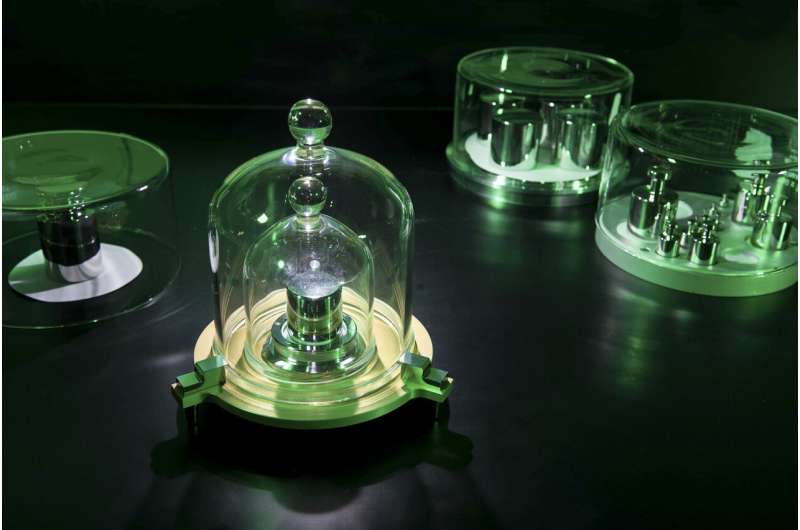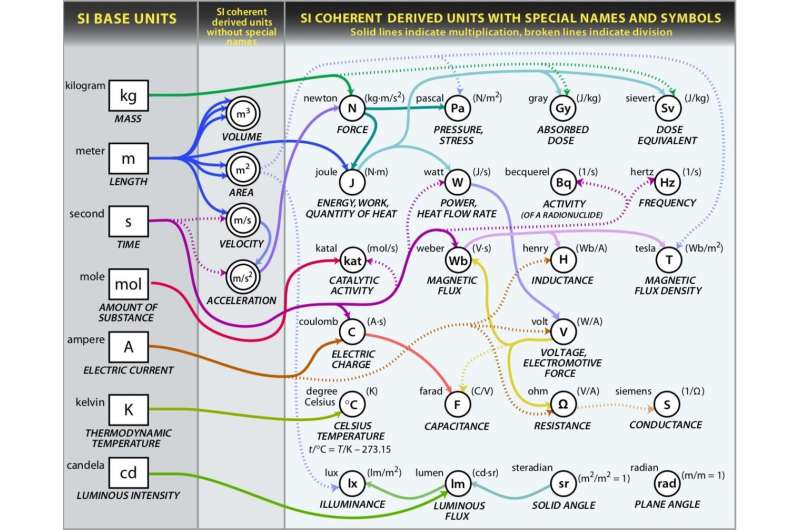All base units of measurement now tied to defined constants rather than physical objects

Scales aren't changing and the weather won't be noticeably different, but on May 20 the definitions that underlie what your scale and thermometer report—along with standard definitions used in chemistry and electronics—are undergoing a major overhaul. That's the date that a more-than-centuries-long process of standardizing measurements reaches its conclusion.
At that time, the way we define an amount of light or electrical current—along with the more familiar measurements of volume and mass—will all be based on descriptions that could be replicated by anyone not just on Earth but in galaxies far, far away.
"Nothing changes and everything changes," said Marc Salit, who helped define these measurements—known as the International System of Units, or SI units—at the National Institute of Standards and Technology for 28 years. He now directs an effort to apply similar rigor to definitions of biological measurements. That effort, called the Joint Initiative for Metrology in Biology, or JIMB (pronounced Jim-Bee), was founded by NIST and Stanford in 2014 and is now part of SLAC National Accelerator Laboratory.
Salit said Monday's changes will be invisible to most people but represent a major change in the field of metrology. He was at the meeting in November where the assembled international representatives voted to adopt the proposed changes.
"It was cool to see the U.S. voting yes, Russia voting yes, Ukraine voting yes and China voting yes. All voting yes to adopt the resolution that redefines the SI," Salit said.
He equates metrology with kids trying to equally share a chocolate bar. "We each have an innate sense of justice and fairness," he said. "This redefined SI is how we share. It's the basis for trade. It's the basis for equity. It's the basis for knowledge that is quantitative and interoperable and communicable."
The international effort to standardize measurements began with a treaty in 1875, when countries recognized the need for a consistent way of measuring products for trade. One early outcome was a standardized kilogram created in 1889 and housed in an underground bunker outside Paris, known as Le Grand Kilo or Le Grand K. Copies exist around the world, but Le Grand K, protected with three sets of keys, set the standard.
Now, a kilogram, like each of the seven base units of measure, will hinge on unchanging properties of nature—the speed of light, the wavelength of known atoms—and all other measurements build on those.

"This represents centuries of work bringing us together to share in a quantitative and repeatable, reproducible, precise manner," Salit said. "That redefinition makes it so that those units are coupled through a harmonious system that could be beamed into space."
To promote their effort, NIST has created superhero personas for each base unit of measure, all united around a common villain—Major Uncertainty (its symbol: the question mark).
Salit's work at JIMB focuses on trying to bring the same absolute specificity to biology. "How do you sequence something in Canada and I sequence it here and how do we compare? How do we make sure we got it right?" he asked.
Salit helped devise standardized controls for measuring the activity of genes and is looking at standardizing descriptions of how scientists measure protein levels.
As with the base units of measure, he said, the goal is to help scientists communicate, share knowledge and ultimately support fair partnership in trade.
Measurements: Similar, accurate, truthful
May 20 also marks the debut of a new book on the history of measurement by Emanuele Lugli, assistant professor of art and art history at the School of Humanities and Sciences. The Making of Measure and the Promise of Sameness (University of Chicago Press) is a quest for the foundations of objectivity through an analysis of the ways measurement standards were made, displayed, used and imagined between the 12th and the 17th century.
"We measure everything we do—the paths we run, the food we eat, the time we sleep—but we rarely consider the ways we measure," Lugli said. "We take what is displayed on our scales and on our apps for granted even if we have no problem questioning the news, the weather forecast, even what our closest friends tell us. We take measuring as a simple, straightforward activity. We place our trust in it like in no other activity. Why? This book turns to the history of medieval and early modern Europe to search for the foundations of such a blind belief."
In his book, Lugli finds many answers in the late 12th century, when the governments of Italy's newly formed city-republics rejected imperial measurement standards and created new local ones, displaying them in their main squares. "This deceptively simple gesture—entirely overlooked by historians—triggered a series of revolutionary practices that not only redefined the cultural landscape of the time, but also laid the foundations of today's ideas about precision, reproducibility and truth," he said. By looking at the very emergence of measurement standards—the ways they were conceived, made, guarded, enforced through the population, and eventually regarded as true—this book exposes power's labors in shaping and merging with the real, Lugli said.
Provided by Stanford University



















